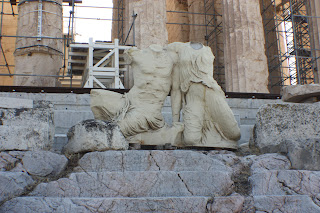How Athens was named was pretty much the base for all of the history Anastasia told us. If you know anything about Greek mythology you have probably heard of Athena, goddess of wisdom. It's obvious to you now that this is who Athens is named for but do you know why? It was Poseiden, god of sea and Athena who 'battled' it out for the name of the city. It's not known exactly how it came down to these two but Zeus, Father of gods, declared that instead of actually battling it out, each would give a gift to the city and the name would go to the gift that was accepted by the citizens.
With all the gods sitting on one side and the citizens on the other, Poseidon struck the rock of the Acropolis with his trident, opening a spring of water that was offering the city success in war and at sea (naval power). Athena then dropped a seed and it instantly turned into an olive tree representing peace and prosperity. The citizens accepted Athena's gift and the owl, the bird that represents her and signifies wisdom, became the pet animal of the city.
Olive trees can be found growing all over Greece, this one happens to be outside Athena's temple.
The Acropolis (means edge or extremity) was built on the edge of the city and was designed as a fortress on the highest point of the city so they had a panoramic view of the surrounding areas and any intruders that tried to enter. It is still used as a guideline and no building can be built higher than the acropolis, no skyscrapers in Athens! The Acropolis houses the Parthenon and the Temple of Poseidon and Athena. Everything is built from marble!
The Parthenon was the first building to be built in the golden ratio (following the laws of nature) and there is not a single straight line in all of the building. It was built 2500 years ago and not once sustained damage from an earthquake (golden ratio=flexible). It took 9 years to build the Parthenon and it's said that with today's technology it could not be built that quickly. It's amazing to think of the technology and man power they had that long ago!
 |
| Replica of statue that would have been outside the Parthenon |
The temple of Poseidon and Athena was built around the rock that Poseidon struck with his trident.
The temple of Hephaestus is the best preserved Greek temple. It is not located in the Acropolis and is lesser known than the Parthenon. It was built 449 BC on what was then the western edge of the city, in a district which contained many metalwork shops. It was therefore, dedicated to Hephaestos, god of blacksmiths.
Our last stop before headed to the airport to catch our flights was the Panathinaiko Stadium. This was the stadium that hosted to first modern Olympics in 1896 and was reconstructed from the remains of an ancient Greek stadium! It was so cool to be there during the Olympics and think about the progression of the Olympics through the years. This stadium holds 60,000 people and during the 2004 Athens Olympics was used for archery and the finish line for the marathon. And of course our visit wasn't complete without a jumping picture and showing our USA pride!
That concludes our Greece trip but check back tomorrow for a few of my favorite things about Greece!















No comments:
Post a Comment